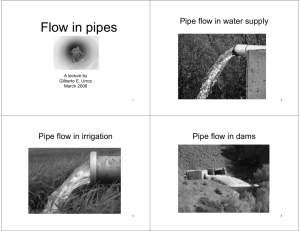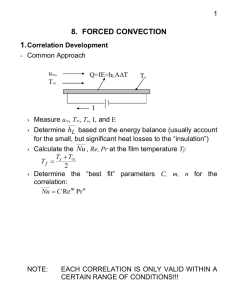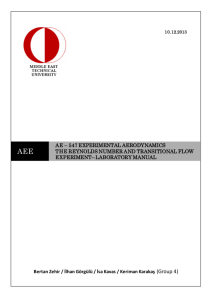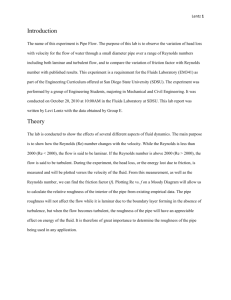2. flow in closed conduits - Middle East Technical University
advertisement
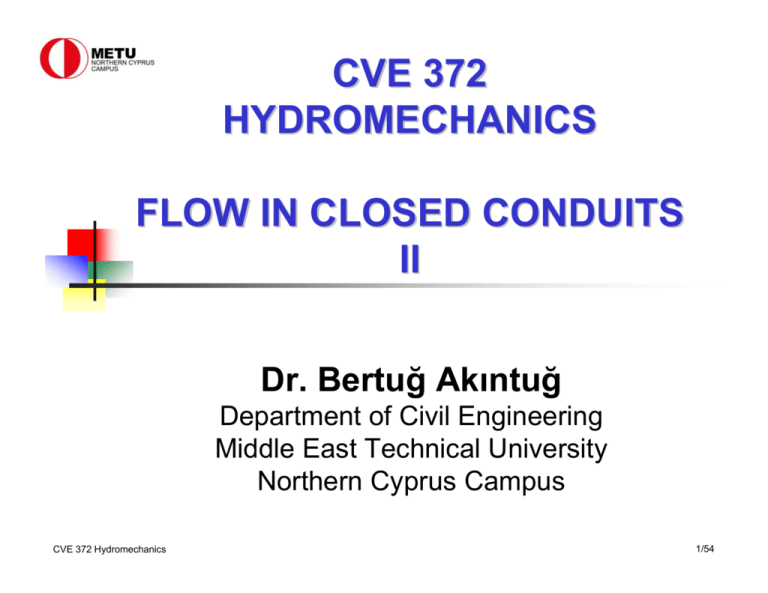
CVE 372 HYDROMECHANICS FLOW IN CLOSED CONDUITS II Dr. Bertuğ Akıntuğ Department of Civil Engineering Middle East Technical University Northern Cyprus Campus CVE 372 Hydromechanics 1/54 2. FLOW IN CLOSED CONDUITS Overview 2.2 Fully Developed Flow in Closed Conduits 2.2.1 Derivation of Darcy-Weisbach Equation 2.2.2 Laminar Flow in Pipes 2.2.3 Turbulent Flow in Pipes 2.2.4 Moody Chart CVE 372 Hydromechanics 2/54 2. FLOW IN CLOSED CONDUITS Fully Developed Flow in Closed Conduits 2.1.1 Derivation of Darcy-Weisbach Equation Consider a steady fully developed flow in a prismatic pipe V1=V2=V A1=A2=A α1=α2=1 β1=β2=1 Assumptions: - Fully developed flow (uniform) - Circular tube (pipe) - Steady Flow CVE 372 Hydromechanics - Incompressible fluid - Constant diameter 3/54 2. FLOW IN CLOSED CONDUITS Fully Developed Flow in Closed Conduits 2.1.1 Derivation of Darcy-Weisbach Equation (a) Relationship between wall shear stress and head loss Continuity Equation Q = V1 A1 = V2 A2 = VA = constant Momentum Equation 0, since β1= β2 p1 A1 − p2 A2 + W sin θ − F f = ρQ(β 2V2 − β1V1 ) where W sin θ = γAL sin θ = γA( z1 − z 2 ) CVE 372 Hydromechanics and F f = τ w PL P: wetted perimeter 4/54 2. FLOW IN CLOSED CONDUITS Fully Developed Flow in Closed Conduits 2.1.1 Derivation of Darcy-Weisbach Equation Momentum Equation gives p1 A1 − p2 A2 + γA( z1 − z 2 ) − τ w PL = 0 τ w LP τ w L = = z1 + − z 2 − γ γ γA γRH p1 p2 where RH is hydraulic radius A πD 2 4 D R = RH = = P πD 4 2 W sin θ = γAL sin θ = γA( z1 − z 2 ) CVE 372 Hydromechanics P: wetted perimeter 5/54 2. FLOW IN CLOSED CONDUITS Fully Developed Flow in Closed Conduits 2.1.1 Derivation of Darcy-Weisbach Equation Momentum Equation gives τ wL z1 + − z 2 − = γ γ γRH p1 p2 Energy Equation gives z1 + p1 γ − z2 − p2 γ = hL τ wL hf = γRH 2τ L hf = w γR 4τ w L hf = γD Note that the above equation is applicable for both laminar and turbulent flows and for open channel flows as well. CVE 372 Hydromechanics 6/54 2. FLOW IN CLOSED CONDUITS Fully Developed Flow in Closed Conduits 2.1.1 Derivation of Darcy-Weisbach Equation (b) Relationship between wall shear stress and velocity Dimensional Analysis τ w = F (V , D, ρ , µ , ε ) shear stress τw = f′⇒ π1 = 2 ρV dynamic pressure ρVD VD = ⇒ Reynolds Number π2 = µ ν ε π 3 = ⇒ Relative Roughness D CVE 372 Hydromechanics π 1 = φ (π 2 , π 3 ) ρVD ε τw = φ , 2 ρV µ D τ w = f ′ρV 2 7/54 2. FLOW IN CLOSED CONDUITS Fully Developed Flow in Closed Conduits 2.1.1 Derivation of Darcy-Weisbach Equation (c) Relationship between head loss and velocity τw ε f′= = function Re, 2 ρV D τ w = f ′ρV 2 ′ V 2L 4τ w L 4 f ρ = hf = γD γD let 8f'=f and g=γ/ρ L V2 ε ⇒ f = function Re, hf = f D D 2g CVE 372 Hydromechanics 8/54 2. FLOW IN CLOSED CONDUITS Fully Developed Flow in Closed Conduits 2.2.2 Laminar Flow in Pipes Local acceleration is zero. Convective acceleration is zero as well as a result of fully developed flow Motion of a cylindrical fluid element within a pipe. Assumptions: - Fully developed flow (uniform) - Circular tube (pipe) - Steady Flow CVE 372 Hydromechanics - Incompressible fluid - Constant diameter 9/54 2. FLOW IN CLOSED CONDUITS Fully Developed Flow in Closed Conduits 2.2.2 Laminar Flow in Pipes Local acceleration is zero. Convective acceleration is zero as well as a result of fully developed flow Free-body diagram of a cylinder of fluid Momentum Equation p1πr 2 − ( p1 − ∆p )πr 2 − τ 2πrl = 0 CVE 372 Hydromechanics ∆p 2τ = l r 10/54 2. FLOW IN CLOSED CONDUITS Fully Developed Flow in Closed Conduits 2.2.2 Laminar Flow in Pipes Shear stress distribution within the fluid in a pipe (laminar or turbulent flow) and typical velocity profiles. 2τ w r τ= D CVE 372 Hydromechanics 4lτ w ∆p = D Small shear stress can produce large pressure difference if l/D is large (relatively long pipe) Applicable to both laminar and turbulent flow in pipes11/54 2. FLOW IN CLOSED CONDUITS Fully Developed Flow in Closed Conduits 2.2.2 Laminar Flow in Pipes For laminar flow of a Newtonian fluid, the shear stress is simply proportional to the velocity gradient (Section 1.6) τ = µ (du/dr). For our pipe flow, ∆p du τ= r = −µ 2l dr The negative sign is included to give τ > with du/dr < 0 ( the velocity decreases from the pipe centerline to the pipe wall) CVE 372 Hydromechanics 12/54 2. FLOW IN CLOSED CONDUITS Fully Developed Flow in Closed Conduits 2.2.2 Laminar Flow in Pipes ∆p du r = − dr 2 µl ∆p 2 )r + C1 integration yields u ( r ) = −( 4 µl We can evaluate the integration constant using the no slip condition at the pipe wall so that u = 0 at r=D/2 and C1=(∆pD2/(16µl)). Hence Centerline (max) velocity Velocity: Vc=(∆pD2/(16µl)). 2 2r 2 ∆pD 2 2r 1 − = Vc 1 − u (r ) = D 16µl D CVE 372 Hydromechanics 13/54 2. FLOW IN CLOSED CONDUITS Fully Developed Flow in Closed Conduits 2.2.2 Laminar Flow in Pipes Integration of u(r) over the pipe area gives volume flowrate R Q = ∫ udA = ∫ u (r )2πrdr = 0 πR 2Vc 2 by definition, the average velocity is the V=Q/A = Q/πR2 π R 2Vc Vc ∆pD 2 V= = = ⇒ 2 2π R 2 32 µl πD 4 ∆p Q= 128µl Above equation is referred to as Poiseuille’s Law. Recall that all of these results are restricted to laminar flow in a horizontal pipe. CVE 372 Hydromechanics 14/54 2. FLOW IN CLOSED CONDUITS Fully Developed Flow in Closed Conduits 2.2.2 Laminar Flow in Pipes Flowrate: πD 4 ∆p Q= 128µl Proportional to the pressure drop Inversely proportional to viscosity Inversely proportional to the pipe length Proportional to the pipe diameter to the fourth power CVE 372 Hydromechanics 15/54 2. FLOW IN CLOSED CONDUITS Fully Developed Flow in Closed Conduits 2.2.2 Laminar Flow in Pipes For Non-horizontal pipe, the adjustment is required by replacing ∆p by (∆p-γl sinθ) where θ is the angle between the pipe and the horizontal. Free-body diagram of a fluid cylinder for flow in a nonhorizontal pipe. ∆p − γl sin θ 2τ (∆p − γl sin θ ) D 2 π (∆p − γl sin θ ) D 4 = V= Q= 32 µl 128µl l r CVE 372 Hydromechanics 16/54 2. FLOW IN CLOSED CONDUITS Fully Developed Flow in Closed Conduits 2.2.2 Laminar Flow in Pipes Example 3: An oil with a viscosity of µ = 0.40 N.s/m2 and density ρ = 900 kg/m3 flow in a pipe of diameter D = 0.020 m. a) What pressure drop, p1-p2, is needed to produce a flowrate of Q = 2.0 x 10-5 m3/s if the pipe is horizontal with x1=0 and x2=10 m? b) How steep a hill, θ, must the pipe be on if the oil is to flow through the pipe at the same rate as in part (a), but with p1 = p2? c) For the conditions of part (b), if p1 = 200 kPa, what is the pressure at section x3 = 5 m, where x is measures along the pipe? Solved in the class room CVE 372 Hydromechanics 17/54 2. FLOW IN CLOSED CONDUITS Fully Developed Flow in Closed Conduits 2.2.2 Laminar Flow in Pipes From dimensional analysis: Assume that ∆p is a function of ∆p = f (V , l , D, µ ) # of variables = 5 and # of dimensions = 3 (M,L,T) According to the result of dimensional analysis (CVE 371), this flow can be described in terms of 5-3=2 dimensionless Group. One such represents D∆p l = φ( ) µV D A further assumption: the pressure drop is directly proportional to the pipe length 4 D∆p Cl ∆p CµV π C pD ( / 4 ) ∆ = ⇒ = ⇒ Q = AV = 2 D µV l D µl CVE 372 Hydromechanics 18/54 2. FLOW IN CLOSED CONDUITS Fully Developed Flow in Closed Conduits 2.2.2 Laminar Flow in Pipes The same functional form as theory implies (π / 4C )∆pD 4 Q = AV = µl Recall average velocity was found to be D 2 ∆p V = 32µl We can divide both sides by the dynamic pressure (recall from Chapter 3) 1 ρV 2 2 µ l 64 l 32 µlV / D 2 = = = 64 1 1 ρVD D Re D ρV 2 ρV 2 2 2 ∆p CVE 372 Hydromechanics 19/54 2. FLOW IN CLOSED CONDUITS Fully Developed Flow in Closed Conduits 2.2.2 Laminar Flow in Pipes This is often written as l ρV 2 ∆p = f D 2 where the dimensionless quantity D 2 f = ∆p 2 l ρV Darcy friction factor For a fully developed laminar flow the friction factor is Alternate expression as a dimensional wall shear stress CVE 372 Hydromechanics f = 64 Re 8τ w f = ρV 2 20/54 2. FLOW IN CLOSED CONDUITS Fully Developed Flow in Closed Conduits 2.2.2 Laminar Flow in Pipes Energy Consideration Recall from Chapter 5 (in the absence of energy sources) p2 V 22 V 21 + α1 + z1 = + α2 + z2 + hL 2g 2g γ γ p1 where alpha values (always >=1) compensate for the fact that velocity profile across the pipe is not uniform (Chapter 5). α1 = α 2 α1V12 / 2 g = α 2V22 / 2 g For fully developed flow velocity profile is constant Hence CVE 372 Hydromechanics p1 p2 + z1 − + z 2 = hL γ γ 21/54 2. FLOW IN CLOSED CONDUITS Fully Developed Flow in Closed Conduits 2.2.2 Laminar Flow in Pipes Remember p1πr 2 − ( p1 − ∆p )πr 2 − τ 2πrl = 0 ∆p 2τ = l r ( p1 γ + z1 ) − ( p2 γ 2τl hL = h f = γr + z 2 ) = hL Using the shear stress at the pipe wall, we have 4lτ w hf = γD CVE 372 Hydromechanics No minor loss Friction loss is proportional to the shear stress, which is proportional to viscosity. 22/54 2. FLOW IN CLOSED CONDUITS Fully Developed Flow in Closed Conduits 2.2.2 Laminar Flow in Pipes In summary Velocity: max. velocity 2 ∆pD 2 2r 1 − u (r ) = 16 µl D Vc = umax 2r 2 or u (r ) = Vc 1 − D Average Velocity: Vc ∆pD V= = 2 32 µl 2 CVE 372 Hydromechanics α1V12 / 2 g = α 2V22 / 2 g 23/54 2. FLOW IN CLOSED CONDUITS Fully Developed Flow in Closed Conduits 2.2.2 Laminar Flow in Pipes In summary Wall Shear Stress: ∆pD τw = 4l or 8µV τw = D Shear Stress: du τ = −µ dr CVE 372 Hydromechanics or 2r τ =τw D 24/54 2. FLOW IN CLOSED CONDUITS Fully Developed Flow in Closed Conduits 2.2.2 Laminar Flow in Pipes In summary Flow Rate: πD 4 ∆p Q = VA = 128µl Friction Loss: 4lτ w hf = γD Friction Factor: CVE 372 Hydromechanics 64 f = Re 32lµV hf = γD 2 f = l V2 hf = f D 2g 8τ w ρV 2 25/54 2. FLOW IN CLOSED CONDUITS Fully Developed Flow in Closed Conduits Example 4: The flow rate Q of corn syrup through the horizontal pipe shown in the figure is to be monitored by measuring the pressure difference between sections (1) and (2). The variations of the syrup’s viscosity and density with temperature are given in the following table a) Determine the wall shear stress and the pressure drop ∆p=p1-p2 for Q=14 lt/s for T=40°C. b) For the condition of part (a), determine the net pressure force and the net shear force on the fluid within the pipe between the section (1) and (2). T (°C) ρ (kg/m3) µ (N.s/m2) 15 1067 1.9152 25 1062 0.9097 40 1057 0.1819 50 1051 0.0211 60 1046 0.0044 70 1041 0.0011 2m 10 cm CVE 372 Hydromechanics Solved in the class room 26/54 2. FLOW IN CLOSED CONDUITS Fully Developed Flow in Closed Conduits 2.2.3 Turbulent Flow in Pipes Transition from Laminar to Turbulent Flow CVE 372 Hydromechanics We slowly increase the flowrate in a long section of a pipe. 27/54 2. FLOW IN CLOSED CONDUITS Fully Developed Flow in Closed Conduits 2.2.3 Turbulent Flow in Pipes Transition from Laminar to Turbulent Flow u(t): instantaneous velocity in the x-direction u’(t): fluctuating part of u(t) The time-averaged, ū, and fluctuating, ú, description of a parameter for tubular flow. CVE 372 Hydromechanics 28/54 2. FLOW IN CLOSED CONDUITS Fully Developed Flow in Closed Conduits 2.2.3 Turbulent Flow in Pipes Turbulent Shear Stress We can write the velocity vector as u = u + u' Fluctuation (time average of fluctuations is zero) Average velocity: Fluctuations are equally distributed on either side of the average. However, the square of fluctuation is always greater than zero. 1 (u ' ) = T 2 1 u= T t o +T ∫ u ( x, y, z, t )dt to t o +T 2 ( u − u ) dt > 0 ∫ to CVE 372 Hydromechanics 29/54 2. FLOW IN CLOSED CONDUITS Fully Developed Flow in Closed Conduits 2.2.3 Turbulent Flow in Pipes Turbulent Shear Stress The structure and characteristics of turbulence may vary from one flow situation to another. A measure of turbulence is called ‘turbulence intensity’ 1 (u ' ) 2 T = u u u dt ( − ) ∫t o u t o +T 2 2 As this parameter increases, the fluctuations of the velocity increases. Well designed wind tunnels have typical values of 0.01 or smaller. CVE 372 Hydromechanics 30/54 2. FLOW IN CLOSED CONDUITS Fully Developed Flow in Closed Conduits 2.2.3 Turbulent Flow in Pipes Turbulent Shear Stress The random velocity components result in momentum transfer in turbulent flow resulting in an additional term in the shear stress expression: du τ =µ − ρ u ' v' = τ lam + τ turb dy If the flow is laminar, then fluctuations vanish and we recover the viscosity expression for Newtonian fluids. The second term is called the turbulent shear stress and it is always positive. Hence the shear stress in turbulent flow is always greater than shear stress in laminar flow. CVE 372 Hydromechanics 31/54 2. FLOW IN CLOSED CONDUITS Fully Developed Flow in Closed Conduits 2.2.3 Turbulent Flow in Pipes Turbulent Shear Stress τlam is dominant τturb is dominant Structure of turbulent flow in a pipe. (a) Shear stress. (b) Average velocity. CVE 372 Hydromechanics 32/54 2. FLOW IN CLOSED CONDUITS Fully Developed Flow in Closed Conduits 2.2.3 Turbulent Flow in Pipes Turbulent Shear Stress Typically turbulent shear stress is 100 to 1000 times greater than the shear stress in the laminar region, while the converse is true in the viscous sublayer. Note that an accurate model of turbulent flow requires the knowledge of Reynolds stresses which require the knowledge of velocity fluctuations which can not be solved for most turbulent flow problems. CVE 372 Hydromechanics 33/54 2. FLOW IN CLOSED CONDUITS Fully Developed Flow in Closed Conduits 2.2.3 Turbulent Flow in Pipes Turbulent Velocity Profile Fully developed turbulent flow in a pipe can be broken into three regions which are characterized by their distances from the wall: CVE 372 Hydromechanics Viscous sublayer: The viscous shear stress is dominant compared with the turbulent (or Reynolds) stress and the random (eddying) nature of flow is absent. In this layer fluid viscosity is important parameter. Overlap region: Transition region Outer turbulent layer: The Reynolds stress is dominant, and there is considerable mixing and randomness of the flow. In this layer density is important parameter. 34/54 2. FLOW IN CLOSED CONDUITS Fully Developed Flow in Closed Conduits 2.2.3 Turbulent Flow in Pipes Turbulent Velocity Profile In the viscous sublayer: u yu ∗ = * u ν where y = R−r τw u = ρ ∗ friction velocity u = the time av. x component of the velocity y = δs: thickness of the viscous sublayer R y CVE 372 Hydromechanics r δs = 5ν Law of the wall, valid very near the smooth wall for 0 ≤ yu ∗ /ν ≤ 5 u* 35/54 2. FLOW IN CLOSED CONDUITS Fully Developed Flow in Closed Conduits 2.2.3 Turbulent Flow in Pipes Turbulent Velocity Profile In the overlap region: yu ∗ u + 5.0 = 2.5 ln * u ν where y = R−r R y r u = the time av. x component of the velocity τw ∗ u = ρ CVE 372 Hydromechanics friction velocity Law of the wall, valid very near the smooth wall for 0 ≤ yu ∗ /ν ≤ 5 36/54 2. FLOW IN CLOSED CONDUITS Fully Developed Flow in Closed Conduits 2.2.3 Turbulent Flow in Pipes Turbulent Velocity Profile In the turbulent region: R Vc − u = 2.5 ln * u y or 1/ n u r = 1 − Vc R CVE 372 Hydromechanics Figure 8.17 Exponent, n, for power-law velocity profiles. Power-Law velocity profile 37/54 2. FLOW IN CLOSED CONDUITS Fully Developed Flow in Closed Conduits 2.2.3 Turbulent Flow in Pipes Turbulent Velocity Profile Typical laminar flow and turbulent flow velocity profiles. CVE 372 Hydromechanics 38/54 2. FLOW IN CLOSED CONDUITS Fully Developed Flow in Closed Conduits 2.2.3 Turbulent Flow in Pipes Example 5: Water at 20°C (ρ=998 kg/m3 and ν=1.004 x 10-6 m3/s) flows through a horizontal pipe of 0.1 m diameter with a flowrate of Q=4x10-2 m3/s and a pressure gradient of 2.59 kPa/m. a) Determine the approximate thickness of the viscous sublayer. b) Determine the approximate centerline velocity, Vc. c) Determine the ratio of the turbulent to laminar shear stress, τturb/ τlam at a point midway between the centerline and the pipe wall (r=0.025 m). Solved in the class room CVE 372 Hydromechanics 39/54 2. FLOW IN CLOSED CONDUITS Fully Developed Flow in Closed Conduits 2.2.3 Turbulent Flow in Pipes Most turbulent pipe flow analyses are based on experimental data and semi-empirical formulas which are expressed in dimensionless forms. We need to determine the head loss. For convenience, we will consider two types of energy losses; minor (local) and major (friction) losses hL = hLmajor + hLminor Note that major and minor losses do not necessarily reflect the magnitude of the energy losses CVE 372 Hydromechanics 40/54 2. FLOW IN CLOSED CONDUITS Fully Developed Flow in Closed Conduits 2.2.3 Turbulent Flow in Pipes Consider the pipe flow again. Pressure drop is a function of a number of physical and geometrical parameters: ∆p = F (V , D, l , ε , µ , ρ ) This time we included a parameter which is a measure of the roughness of the pipe wall (unit is length) CVE 372 Hydromechanics 41/54 2. FLOW IN CLOSED CONDUITS Fully Developed Flow in Closed Conduits 2.2.3 Turbulent Flow in Pipes There are seven parameters and three reference dimensions. ∆p ~ ρVD l ε =φ ( , , ) 2 1 / 2 ρV µ D D Reynolds number Dynamic pressure CVE 372 Hydromechanics 42/54 2. FLOW IN CLOSED CONDUITS Fully Developed Flow in Closed Conduits 2.2.3 Turbulent Flow in Pipes Let’s assume that pressure drop is proportional to the length of the pipe: ∆p ε l = φ (Re, ) 2 1 / 2 ρV D D Recall that f = ε ∆pD is the friction factor. Then we have f = φ (Re, ) 2 D lρV / 2 The energy equation for steady, incompressible flow is given by p1 γ CVE 372 Hydromechanics + α1V 21 2g + z1 = p2 γ + α 2V 2 2 2g + z 2 + hL 43/54 2. FLOW IN CLOSED CONDUITS Fully Developed Flow in Closed Conduits 2.2.3 Turbulent Flow in Pipes For constant diameter, horizontal pipe with fully developed flow (alphas are equal) hLmajor l V2 = f D 2g This is called Darcy-Weisbach equation For nonhorizontal pipes p1 − p2 = γ ( z1 − z 2 ) + γhLmajor CVE 372 Hydromechanics l V2 = γ ( z1 − z 2 ) + f D 2g 44/54 2. FLOW IN CLOSED CONDUITS Fully Developed Flow in Closed Conduits 2.2.3 Turbulent Flow in Pipes The Moody Chart. For laminar flow: f=64/Re For turbulent flow: ε / D 1 2.51 = −2 log + 3.7 Re f f CVE 372 Hydromechanics for large values, f is independent of 45/54 Re 2. FLOW IN CLOSED CONDUITS Fully Developed Flow in Closed Conduits 2.2.3 Turbulent Flow in Pipes Smooth Pipe and Hydraulically Smooth Flow 2.51 1 = −2 log Re f f Colebrook – White Transition Flow ε / D 1 2.51 = −2 log + f 3.7 Re f Rough Pipe Hydraulically Rough Flow 1 ε / D = −2 log f 3. 7 CVE 372 Hydromechanics 46/54 2. FLOW IN CLOSED CONDUITS Fully Developed Flow in Closed Conduits 2.2.4 Moody Diagram CVE 372 Hydromechanics 47/54 2. FLOW IN CLOSED CONDUITS Fully Developed Flow in Closed Conduits 2.2.4 Moody Diagram CVE 372 Hydromechanics 48/54 2. FLOW IN CLOSED CONDUITS Fully Developed Flow in Closed Conduits 2.2.4 Moody Diagram Loss coefficient for a sudden expansion. Conservation of mass A1V1 = A3V3 Conservation of momentum p1 A3 − p3 A3 = ρA3V3 (V3 − V1 ) Note that: Conservation of energy V 21 p3 V 2 3 + = + + hL γ 2g γ 2g p1 CVE 372 Hydromechanics 2 K L = hL /(V1 / 2 g ) A1 2 K L = (1 − ) A2 49/54 2. FLOW IN CLOSED CONDUITS Fully Developed Flow in Closed Conduits Example 6: A soft drink with the properties of 10°C water is sucked through a 4 mm diameter, 0.25 m long straw at a rate of 4 cm3/s. Is the flow at the outlet of the straw laminar? Is it fully developed? Solved in the class room CVE 372 Hydromechanics 50/54 2. FLOW IN CLOSED CONDUITS Fully Developed Flow in Closed Conduits Example 7: 0.5 m D=10 mm Entrance K=0.5 Given Q=3.6 lt/min L=2 m a) Determine the state of the flow and velocity in the pipe. b) Draw E.G.L. and H.G.L. and determine the kinematics viscosity. Solved in the class room CVE 372 Hydromechanics 51/54 2. FLOW IN CLOSED CONDUITS Fully Developed Flow in Closed Conduits Exercise 1: Water at 20°C flows in a 15 cm diameter pipe with a flowrate of 60 lt/s. a) Determine the centerline velocity. (Ans: 4.06 m/s) b) What is the approximate velocity at a distance 5 cm away from the wall? (Ans: 3.86 m/s) CVE 372 Hydromechanics 52/54 2. FLOW IN CLOSED CONDUITS Fully Developed Flow in Closed Conduits Exercise 2: For a smooth pipe of diameter 75 mm, the head loss for a distance of 150 m is 21 m. When the flowrate is 8.5 lt/s. Is the flow laminar or turbulent? (Ans: laminar) CVE 372 Hydromechanics 53/54 2. FLOW IN CLOSED CONDUITS Fully Developed Flow in Closed Conduits Exercise 3: The pressure heads measured in a 2 cm diameter circular pipe are p1/γ = 22 m and p2/γ = 21.5 m. The distance between two measuring points is 1500 m. Taking γ=9810 N/m3, ρ= 1000 kg/m3, ν=1x10-6 m2/s determine: a) State of the flow b) The equation of velocity and shear stress profiles c) Maximum velocity d) Velocity and shear stress at r=5 mm and y=4 mm. e) Discharge ANS: (a) laminar, (b) u=0.0816-816r2, τ=1.635r, (c)=0.0816 m/s, (d) u(r=5mm)=0.0612 m/s, τ(r=5mm)=0.008175 N/m2 u(y=4mm)=0.0522 m/s, τ(y=4mm)=0.00981 N/m2, (e) 1.282 x 10-5 m3/s CVE 372 Hydromechanics 54/54



